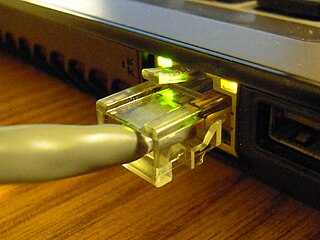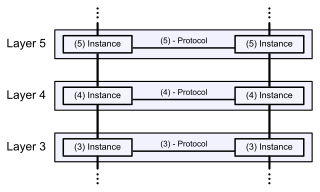
Ethernet is a family of wired computer networking technologies commonly used in local area networks (LAN), metropolitan area networks (MAN) and wide area networks (WAN). It was commercially introduced in 1980 and first standardized in 1983 as IEEE 802.3. Ethernet has since been refined to support higher bit rates, a greater number of nodes, and longer link distances, but retains much backward compatibility. Over time, Ethernet has largely replaced competing wired LAN technologies such as Token Ring, FDDI and ARCNET.
Multiprotocol Label Switching (MPLS) is a routing technique in telecommunications networks that directs data from one node to the next based on labels rather than network addresses. Whereas network addresses identify endpoints, the labels identify established paths between endpoints. MPLS can encapsulate packets of various network protocols, hence the multiprotocol component of the name. MPLS supports a range of access technologies, including T1/E1, ATM, Frame Relay, and DSL.
In computer networking, the maximum transmission unit (MTU) is the size of the largest protocol data unit (PDU) that can be communicated in a single network layer transaction. The MTU relates to, but is not identical to the maximum frame size that can be transported on the data link layer, e.g., Ethernet frame.

The Open Systems Interconnection (OSI) model is a reference model from the International Organization for Standardization (ISO) that "provides a common basis for the coordination of standards development for the purpose of systems interconnection." In the OSI reference model, the communications between systems are split into seven different abstraction layers: Physical, Data Link, Network, Transport, Session, Presentation, and Application.
Quality of service (QoS) is the description or measurement of the overall performance of a service, such as a telephony or computer network, or a cloud computing service, particularly the performance seen by the users of the network. To quantitatively measure quality of service, several related aspects of the network service are often considered, such as packet loss, bit rate, throughput, transmission delay, availability, jitter, etc.
Voice over Internet Protocol (VoIP), also known as IP telephony, refers to a set of technologies used for voice communication sessions over Internet Protocol (IP) networks, such as the Internet. VoIP enables voice calls to be transmitted as data packets, facilitating various methods of voice communication, including traditional applications like Skype, Microsoft Teams, Google Voice, and VoIP phones. Regular telephones can also be used for VoIP by connecting them to the Internet via analog telephone adapters (ATAs), which convert traditional telephone signals into digital data packets that can be transmitted over IP networks.

A virtual local area network (VLAN) is any broadcast domain that is partitioned and isolated in a computer network at the data link layer. In this context, virtual refers to a physical object recreated and altered by additional logic, within the local area network. Basically, a VLAN behaves like a virtual switch or network link that can share the same physical structure with other VLANs while staying logically separate from them. VLANs work by applying tags to network frames and handling these tags in networking systems, in effect creating the appearance and functionality of network traffic that, while on a single physical network, behaves as if it were split between separate networks. In this way, VLANs can keep network applications separate despite being connected to the same physical network, and without requiring multiple sets of cabling and networking devices to be deployed.
A multilayer switch (MLS) is a computer networking device that switches on OSI layer 2 like an ordinary network switch and provides extra functions on higher OSI layers. The MLS was invented by engineers at Digital Equipment Corporation.
Network congestion in data networking and queueing theory is the reduced quality of service that occurs when a network node or link is carrying more data than it can handle. Typical effects include queueing delay, packet loss or the blocking of new connections. A consequence of congestion is that an incremental increase in offered load leads either only to a small increase or even a decrease in network throughput.
VoIP spam or SPIT is unsolicited, automatically dialed telephone calls, typically using voice over Internet Protocol (VoIP) technology.
Cisco Discovery Protocol (CDP) is a proprietary data link layer protocol developed by Cisco Systems in 1994 by Keith McCloghrie and Dino Farinacci. It is used to share information about other directly connected Cisco equipment, such as the operating system version and IP address. CDP can also be used for On-Demand Routing, which is a method of including routing information in CDP announcements so that dynamic routing protocols do not need to be used in simple networks.

A VoIP phone or IP phone uses voice over IP technologies for placing and transmitting telephone calls over an IP network, such as the Internet. This is in contrast to a standard phone which uses the traditional public switched telephone network (PSTN).
In computer networking, jumbo frames are Ethernet frames with more than 1500 bytes of payload, the limit set by the IEEE 802.3 standard. The payload limit for jumbo frames is variable: while 9000 bytes is the most commonly used limit, smaller and larger limits exist. Many Gigabit Ethernet switches and Gigabit Ethernet network interface controllers and some Fast Ethernet switches and Fast Ethernet network interface cards can support jumbo frames.

A computer network is a set of computers sharing resources located on or provided by network nodes. Computers use common communication protocols over digital interconnections to communicate with each other. These interconnections are made up of telecommunication network technologies based on physically wired, optical, and wireless radio-frequency methods that may be arranged in a variety of network topologies.
In audio and broadcast engineering, audio over Ethernet (AoE) is the use of an Ethernet-based network to distribute real-time digital audio. AoE replaces bulky snake cables or audio-specific installed low-voltage wiring with standard network structured cabling in a facility. AoE provides a reliable backbone for any audio application, such as for large-scale sound reinforcement in stadiums, airports and convention centers, multiple studios or stages.
Mobile VoIP or simply mVoIP is an extension of mobility to a voice over IP network. Two types of communication are generally supported: cordless telephones using DECT or PCS protocols for short range or campus communications where all base stations are linked into the same LAN, and wider area communications using 3G or 4G protocols.
Voice over Internet Protocol (VoIP) recording is a subset of telephone recording or voice logging, first used by call centers and now being used by all types of businesses. There are many reasons for recording voice over IP call traffic such as: reducing company vulnerability to lawsuits by maintaining recorded evidence, complying with telephone call recording laws, increasing security, employee training and performance reviews, enhancing employee control and alignment, verifying data, sharing data as well as customer satisfaction and enhancing call center agent morale.
CobraNet is a combination of software, hardware, and network protocols designed to deliver uncompressed, multi-channel, low-latency digital audio over a standard Ethernet network. Developed in the 1990s, CobraNet is widely regarded as the first commercially successful audio-over-Ethernet implementation.
AES67 is a technical standard for audio over IP and audio over Ethernet (AoE) interoperability. The standard was developed by the Audio Engineering Society and first published in September 2013. It is a layer 3 protocol suite based on existing standards and is designed to allow interoperability between various IP-based audio networking systems such as RAVENNA, Wheatnet, Livewire, Q-LAN and Dante.

Audio Video Bridging (AVB) is a common name for a set of technical standards that provide improved synchronization, low latency, and reliability for switched Ethernet networks. AVB embodies the following technologies and standards:







